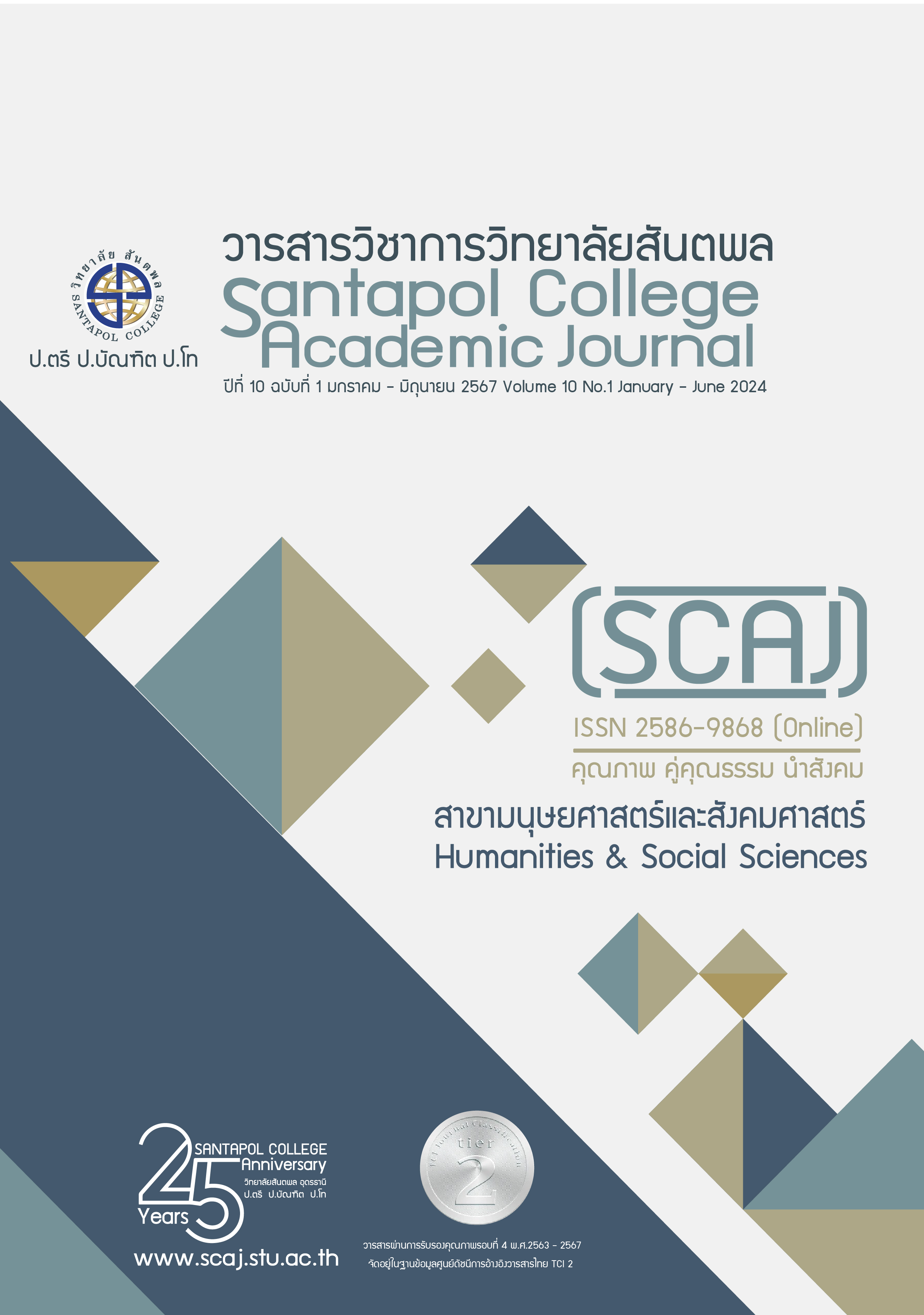ผลของการจัดกิจกรรมพลศึกษาด้วยการเต้นแอโรบิกที่มีต่อสุขภาพสมองของนักเรียน ชั้นประถมศึกษา
Main Article Content
บทคัดย่อ
การวิจัยในครั้งนี้มีวัตถุประสงค์เพื่อศึกษาและเปรียบเทียบผลของการจัดกิจกรรมพลศึกษาด้วยการเต้นแอโรบิกที่มีผลต่อสุขภาพสมองของนักเรียนชั้นประถมศึกษาในด้านความจํา ความสามรถในการควบคุมและยับยั้ง ความยืดหยุ่นทางความคิด และความสามารถด้านมิติสัมพันธ์กลุ่มตัวอย่าง คือ นักเรียนชั้นประถมศึกษาปี่ที่ 4-6 จํานวน 40 คน เครื่องมือที่ใช้ในการวิจัย ได้แก่ แผนกิจกรรมพลศึกษาด้วยการเต้นแอโรบิก และแบบทดสอบความสามารถทางสมองด้วยโปรแกรมคอมพิวเตอร์ (The Computerized test battery CNS Vital Signs) ประกอบด้วย แบบทดสอบTrail Making Test (TMT) ในการวัดภาพสมองด้านความจํา แบบทดสอบ Flanker Test (FKT) ในการวัดสุขภาพสมองด้านความสามรถในการควบคุมและยังยั้ง แบบทดสอบ Design Fluency Test (DFT)
ในการวัดสุขภาพสมองด้านความยืดหยุ่นทางความคิด และแบบทดสอบ Mental Rotation Test (MRT) ในการวัดสุขภาพสมองด้านความสามาถด้านมิติสัมพันธ์วิเคราะห์ข้อมูลโดยใช้การวิเคราะห์ความแปรปรวนทางเดียวแบบวัดซ้ำ (One-way ANOVA Repeated Measures) และทดสอบความแตกต่างคะแนนเฉลี่ยเป็นรายคู่ด้วยการทดสอบ Bonferroni Test ที่นัยสําคัญทางสถิติที่ระดับ .05
ผลการศึกษาพบว่า สุขภาพสมองของนักเรียนทุกด้านดีขึ้น เมื่อเปรียบเทียบความแตกต่างรายคู่พบว่า ทุกการทดสอบมีความแตกต่างกันทุกช่วงการทดลองโดยหลังการทดลองสัปดาห์ที่ 8 จะมีค่าเฉลี่ยสูงกว่าสัปดาห์ที่ 4 และก่อนการทดลอง อย่างมีนัยสําคัญทางสถิติที่ระดับ .05 ผลการวิจัยนี้แสดงให้เห็นว่า การจัดกิจกรรมพลศึกษาด้วยการเต้นแอโรบิก ช่วยส่งเสริมสุขภาพสมองของนักเรียนชั้นประถมศึกษาได้อย่างมีประสิทธิภาพ และสามารถนําไปใช้ในการจัดกิจกรรมการเรียนรู้พลศึกษา เพื่อให้เกิดการพัฒนาทักษะการเคลื่อนไหว ระบบประสาทสัมผัสและศักยภาพในการเรียนรู้
Article Details

อนุญาตภายใต้เงื่อนไข Creative Commons Attribution-NonCommercial-NoDerivatives 4.0 International License.
เนื้อหาและข้อมูลในบทความที่ลงตีพิมพ์ในวารสารวิชาการวิทยาลัยสันตพล ถือว่าเป็นข้อคิดเห็นและความรับผิดชอบของผู้เขียนบทความโดยตรง ซึ่งกองบรรณาธิการวารสารไม่จำเป็นต้องเห็นด้วยหรือรับผิดชอบใดๆ
เอกสารอ้างอิง
กระทรวงศึกษาธิการ. (2551). หลักสูตรแกนกลางขั้นพื้นฐาน. กรุงเทพฯ: โรงพิมพ์ชุมนุมสหกรณ์การเกษตรแห่งประเทศไทย.
วรัญญา ทองใบ. (2563). ผลของโปรแกรมการออกกำลังกายแบบหนักสลับเบาที่มีต่อสุขสมรรถนะของนักเรียนมัธยมศึกษาตอนต้น ที่มีภาวะน้ำหนักเกิน. (ปริญญานิพนธ์การศึกษามหาบัณฑิต). พิษณุโลก: มหาวิทยาลัยนเรศวร.
วายุ กาญจนศร. (2556). การเต้นแอโรบิก (Aerobic Dance): การเต้นเพื่อพัฒนาระบบหัวใจไหลเวียนโลหิต สมาธิ และความจำ. วารสารศึกษาศาสตร์
มหาวิทยาลัยขอนแก่น, 36(1), 3-4.
วาสนา คุณาอภิสิทธิ์ (2556). เป้าหมายของการจัดกิจกรรมทางกายในสถานศึกษาให้สอดคล้องกับหลักสูตรแกนกลางการศึกษาขั้นพื้นฐาน. วารสารสุขศึกษา พลศึกษา และนันทนาการ, 39(1), 16-39.
อัชรัฐ ยงทวี. (2563). ความฉลาดทางการกีฬา: บทบาทของความสามารถทางสมองที่มีต่อความสําเร็จทางการกีฬาในนักกีฬาเยาวชนไทย. กรุงเทพฯ: กรมพลศึกษา กระทรวงการท่องเที่ยวและกีฬา.
American College of Sport Medicine. (1990).Trending Topic | Physical Activity Guidelines. Boston University Medicine Center. (2013). Chobanian & Avedisian School of Medicine, 1225.Cairney, J., Veldhuizen, S., Kwan, M., Hay, J., & Faught, B. E. (2014). Biological age and sex-related declines in physical activity during adolescence. Med Sci Sports Exerc, 46(4), 730–735.
Caspersen, C. J., Powell, K. E., & Christenson, G. M. (1985). Physical activity, exercise, and physical fitness: definitions and distinctions for health-related research. Public Health Rep, 100(2), 126–131.
Clapp, M., Aurora, N., Herrera, L., Bhatia, M., Wilen, E., & Wakefield, S. (2017). Gut microbiota's effect on mental health: The gut-brain axis. Clinics and practice, 7(4), 987. https://doi.org/10.4081/cp.2017.987
Cohen, J. (1998). Statistical Power Analysis for the Behavioural Sciences. Lawrence Erlbaum Associates, Hillsdale.
De Greeff, Johannes W. et al. 2017. Effects of physical activity on executive functions, attention and academic performance in preadolescent children: a meta-analysis. J of Science and Medicine in Sport, 21(5), 501 – 507. https://doi.org/10.1016/j.jDe Gaafsams.2017.09.595
Dumith, S. C., Gigante, D. P., Domingues, M. R., & Kohl H. W. 3rd. (2011). Physical activity change during adolescence: a systematic review and a pooled analysis. Int J Epidemiol, 40(3), 685–698.
Lambrick, D., Stoner, L., Grigg, R., & Faulkner, J. (2016). Effects of continuous and intermittent exercise on executive function in children aged 8-10 years. Psychophysiology, 53(9), 1335–1342. https://doi.org/10.1111/psyp.12688
Nader, P. R., Bradley, R. H., Houts, R. M., McRitchie, S. L., & O'Brien, M. (2008). Moderate-to-vigorous physical activity from ages 9 to 15 years. JAMA,300(3), 295–305.
Shen, Y., Zhao, Q., Huang, Y., Liu, G., & Fang, L. (2020). Promotion of street-dancetraining on the executive function in preschool children. Frontiers in Psychology, 11(2817). 205–210.
Shephard & Astrand. (1992). Endurance in sport, 121-125.
Simos, P. G., Fletcher, J. M., Sarkari, S., Billingsley, R. L., Francis, D. J., Castillo, E. M., Pataraia, E., Denton, C., & Papanicolaou, A. C. (2005). Early development of neurophysiological processes involved in normal reading and reading disability: a magnetic source imaging study. Neuropsychology, 19(6), 787–798. https://doi.org/10.1037/0894-4105.19.6.787
Troiano, R. P., Berrigan, D., Dodd, K. W., Masse, L.C., Tilert, T., & McDowell. M. (2008). Physical activity in the United States measured by accelerometer. Medicine and Science in Sports and Exercise, 40(1),181–188.
Yetti, E., Syarah, E. S., Pramitasari, M., Syarfina, S., & Susanti, D. (2019). The influence of the dance creativity on executive functions of early childhood. Education and Humanities Researc, 225, 258-261.
Zinelabidine, K., Elghoul, Y., Jouira, G., & Sahli, S. (2022). The Effect of an 8-Week Aerobic Dance Program on Executive Function in Children. Perceptual and Motor Skills, 129(1), 153–175.


